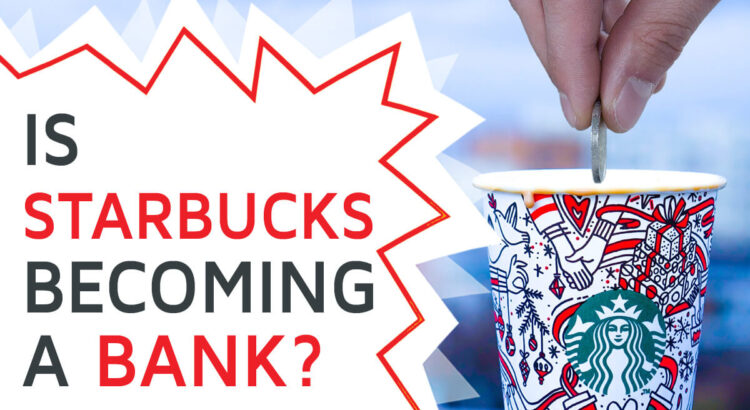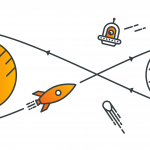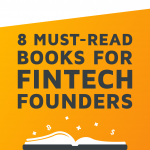
Starbucks could be turning into a bank. Not that they talk much about this fact. But for a few years, the coffee giant doesn’t content itself with brewing up your morning cup of coffee only. They’re brewing up their own financial services, too.
At the center of this venture stands the Starbucks App and the in-house loyalty program Starbucks Rewards. Together, those components have formed an unlikely financial services ecosystem enclosed in the Starbucks brand. The Starbucks App allows customers to order and pay contactless in Starbucks branches. And by paying like this, they also gather loyalty points for the Starbucks Rewards program to spend on benefits.
This development has only accelerated over the years. Yet, it also has suffered pushback in the recent past, when Starbucks changed the loyalty points/free drinks ratio – making some items cheaper and others more expensive in terms of loyalty points to spend getting them. Yet, the outrage only proves how popular Starbucks’ Rewards program is.
And one other popular practice related to the Starbucks App has made headlines over the last years: As user numbers of the Starbucks App rise, so does the amount of money deposited on their prepaid cards. Electronic money laying unused on card accounts… has Starbucks turned into a bank? And is this a business model, other companies might want to adopt?
Well, don’t start depositing your spare change into a latte cup, just yet. Let’s take a look at what’s really going on behind the scenes first. In the following paragraphs, we will explore:
- How Starbucks turned from a coffeehouse to a fintech player
- Which benefits the company reaps from its financial services
- If Starbucks is actually a bank now
- How other companies can embark on the same route as Starbucks – and profit from it
How It All Started – From Gift Cards to Embedded Finance
It all started with a simple gift card. In 2001, Starbucks launched a reloadable card as an alternative to their one-time gift cards. The café group was one of the first retail companies to offer such a prepaid card. It was a gift card that never expired and granted access to rewards such as free refills and free drink customization.
In 2009, the company took this loyalty program into the digital realm with MyStarbucks. This little mobile app introduced us to the star of the show. Or rather, the Stars. The so named virtual currency acted as the medium of exchange in the loyalty program Starbucks Rewards. For each dollar spent on food or drinks, customers would get one Star. Afterward, they could trade the Stars in for drinks, extras, meals and the like.
In 2015, the app finally ventured into the preliminaries of embedded finance. Customers were enabled to order their drinks and pay for them in the app using the Mobile Order and Pay feature. It is tied to a virtual Starbucks Card (which may have a physical counterpart). Via the app, customers can top-up this card with a predefined fixed amount of money (remember, reloadable credit). The app is also the home of the Starbucks Rewards program and manages a virtual currency account filled with Stars from the loyalty program.
And that is where the brilliant twist kicks in, which makes the app highly worthwhile for coffee lovers: Not only did the new app version offer a convenient way to skip ahead in line during rush hours at the local Starbucks. Those who put money in the Starbucks App to pay for their order receive 2 Stars for 1$ instead of 1. Double the loyalty points, double the free Americanos.
Stars and Bucks – the Impact of Mobile Order and Pay
Now, did Starbucks digital app-based payments, virtual currencies and cross-service marketing pay off?
Well, did they ever! The Starbucks loyalty program is one of the most popular reward programs in the whole retail industry. It enrolled over 16 million people until 2019. During the pandemic, the growth rates skyrocketed once more, bringing in an extra 13 million. By the end of 2022, almost 29 million users had joined.1
Starbucks’ payment methods are also popular among the coffee-loving crowd. 41% of customers in the U.S. regularly pay via Starbucks Cards in branch stores, and 21% pay via the Starbucks App (as of 2020). The coffee dealer has also integrated popular payment methods like Apple Pay, Google Pay, Cash App, etc. to increase their app’s appeal even more. 2
Starbucks Goes Fintech
Before we get into Starbucks’ banking capabilities, we start at one step below. Let’s state the obvious: Starbucks is a fintech company.
And the coffee maker is not alone.
The move to offer embedded financial services or custom payment methods in a closed ecosystem is not unheard of among retailers and tech firms. In fact, non-traditional players are increasingly entering the financial services industry with innovative digital offerings. Walmart for instance has already shown similar ambitions, partnering up with payment providers.
As noted by McKinsey, retailers like Starbucks, with its massive customer base and digital expertise, are perfectly positioned to take advantage of this trend.
For instance, the Starbucks rewards program resembles those offered by traditional banks and credit card companies. Using the Starbucks Card comes with extra benefits – and that makes it attractive for customers. Starbucks also introduced a subscription service where the card in the app is automatically topped up each month.
The Starbucks Formula
Yet, running a payment app doesn’t turn Starbucks into a fully-fledged bank, does it?
What makes the difference here is not the payment via the app – it’s the deposited money on the prepaid card, which customers won’t touch again. Of the balances stored in Starbucks gift cards, around 10% don’t get used – often because customers lose their cards or forget they have them. In retail terms, those unused balances are called breakage.
Now, banks also store their customers’ money. They pay out interest on their savings, too. Starbucks doesn’t pay any interest to store money for customers. The company is making a profit by having unused money in its system – the breakage that customers paid for without receiving service for it.
And all of that adds up to something: In 2021, Starbucks derived around 43% of their overall revenue from their gift cards sector.3 By the end of the same year, the company’s cards held around $1.64 billion in balance.4 That’s more than 85% of U.S. banks have on their deposit accounts individually. It’s money that adds to Starbucks’ revenue figures. And it’s money, that covers around ~6% of Starbucks’ liabilities – money, that the company can work with, just like a bank. In 2021, the money Starbucks gained from the breakage amounted to $181 million, according to Bloomberg.
Thus, customers are effectively lending money to Starbucks, with an interest rate of around -10% (due to the breakage) as John Paul Koning pointed out.5 Kim Jung-tai, chairman of the Korean Hana Financial Group, put it more boldly: “It will be fine to call Starbucks an unregulated bank, not a mere coffee company.” In 2022, the Starbucks case was also brought to the attention of the U.S. Securities and Exchange Commission, via a letter sent by the labor federation Strategic Organizing Center. They fear that investors are left in the dark about the Starbucks disclosure regarding breakage.
Starbucks Lacks Real Banking Services
Still, this notion would perhaps go one step too far. True, from the perspective of Starbucks, the company enjoys a few benefits associated with banks. But from the customers’ perspective, Starbucks is not yet a bank. At least, when we look at what kinds of financial services the coffee provider offers. In stark contrast to real bank accounts, the funds on Starbucks Cards and in the Starbucks App can only be spent on products made by Starbucks.
It’s simply a closed-circle mobile payment app, with a loyalty bonus program attached to it (and a good one at that, by loyalty program standards).
That means, there is no cash withdrawal option for the app. Customers may store money on their Starbucks Cards via the app. There is no way to get it back, except perhaps as a goodwill gesture by the customer support team. So, unlike banks, the Starbucks App is not a source of cash. Depositing funds on a Starbucks Card means converting it to “coffee money” forever.
What’s more, Starbucks does not lend out money to its customers, like banks typically do.
Could Starbucks Become a Bank?
All of this doesn’t mean that Starbucks doesn’t want to make the jump to full banking services in the future. As we’ve seen with the rise of fintech companies and the increasing acceptance of digital banking, the financial services industry is rapidly evolving. And with the support of the right partners, who have experience navigating the regulatory landscape, Starbucks might have a shot at pulling this off.
But as much as we would adore a pumpkin-spiced latte bank, let’s not forget the potential for failure. While it’s true that Starbucks has a loyal customer base, banking is a whole different ball game. It’s not just about brewing a good cup of coffee.
Traditional banks and financial institutions adhere to a plethora of regulations. Those range from KYC (know your customer) requirements to anti-money laundering laws. Banking is about ensuring the security and stability of customers’ finances and having reserves deposits and risk-aversion strategies in place.
If Starbucks wanted though, they could try to become a bank and would be in a good position to. And that’s what makes traditional financial institutes nervous. Especially, if the Starbucks model would act as a blueprint for other retail businesses as well.
How Retailers Can Benefit From the Starbucks Model
The retail industry is facing a massive disruption due to the rise of e-commerce. Companies like Starbucks are looking for ways to stay relevant. Ultimately that often means becoming more digital themselves and providing a mostly frictionless consumer experience.
And Starbucks is not the only company lining up. Just look at companies like Amazon, who have reaped huge financial benefits from their embedded finance activities. Amazon, for instance, has its own credit card, and they also offer loans to small businesses through Amazon Lending. Walmart has a credit card and they have also begun offering check cashing and money transfer services.
Linking loyalty programs and financial services, just like Starbucks did, can bring retailers a lot of benefits. Those include:
- Increased Revenue: Reducing friction in payment through in-house payment apps and prepaid cards, paired with loyalty programs and bonuses can cause customers to spend more at shops.
- Deeper Customer Relationships: Linking payments to other incentives will encourage customers to interact with the brand more often and become more loyal to it.
- Better Insights Into Customer Behavior: Processing payment via an in-house platform allows leverage of customer data and leads to a better understanding of their spending habits and payment preferences and enables businesses to personalize the offerings.
- Breakage Profits: As described above, a gift card system will generate revenue that is not completely translated into customer purchases, giving your business more financial flexibility.
The list goes on.
You Can Do It Like Starbucks (With the Right Tech!)
Offering embedded finance as a retail company comes with initial efforts, risks, and challenges. For instance, compliance with regulations and protecting customer data are of the utmost importance. Both require significant resources and expertise. As a business, you should prepare to compete with established players in the industry.
And ultimately, every embedded finance solution enhancing your platform is only as good as the underlying technology. It’s this software that manages the customer’s money, after all.
At trimplement, we have a solution that makes the transition easier for your company. It’s based on more than 10 years of experience creating feature-rich payment software for companies in industries like retail, automotive and banking.
CoreWallet is an all-in-one payment software framework. It provides businesses with all the elements necessary to build a secure, reliable payment and e-wallet system – from issuing virtual currencies for loyalty programs to processing online payments to keeping up with risk and fraud prevention as well as KYC regulations.
The best thing is, that CoreWallet is not only flexible to build the solution that exactly matches your needs. It also empowers you to create such a solution in a short time to market. As of now, payment products built with CoreWallet are in use in more than 50 countries worldwide. The software makes it easy for businesses to offer financial services to their customers, while also increasing revenue and improving customer loyalty.
Contact us at info@trimplement.com and let’s discuss business!
Sources
- Fortune, 2023: “Two business school professors break down the deeper reasons why Starbucks customers were so enraged when the company changed its loyalty program”
- The Verge, 2020: “Starbucks says nearly a quarter of all US retail orders are placed from a phone”
- Bloomberg, 2022: “Starbucks’ $181 Million in Unused Gift Cards Spurs Labor Group Complaint”
- Business Insider, 2022: “Starbucks customers have more than $1 billion sitting on gift cards”
- John Paul Koning, 2019: Twitter


